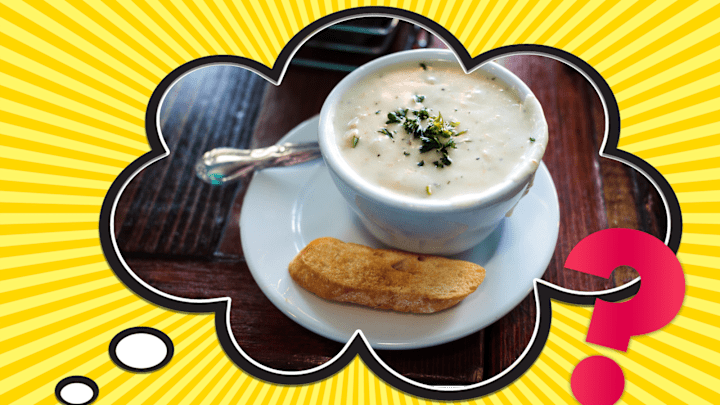Depending on where in the country you’re dining, ordering the clam chowder can lead to drastically different meals. Fans of the Manhattan style may claim theirs is the true version of the soup, while New Englanders would sooner step foot in Yankee Stadium than try it. Manhattan and New England clam chowder are two of the most divisive dishes in American cuisine. Before you can form an opinion on their rivalry, it helps to know what the difference is.
A chowder falls between soup and a stew on the scale of meals you can eat with a spoon. It's characterized by chunky components such as seafood and potatoes in a flavorful liquid. According to some definitions, chowders must be creamy, which is essential to the New England version. The regional specialty traditionally consists of clams, celery, onions, potatoes, and often cured pork in a creamy soup base. The recipe reportedly dates back to the 17th century, when French sailors traveling to New England used local ingredients to recreate the rich soups from their homeland. The similarity between “chowder” and chaudiere, the French word for “cauldron,” supports this theory.
The addition of milk or cream is one of two major qualities that distinguishes New England clam chowder. The other is something it lacks: tomato. Manhattan clam chowder has many of the same ingredients as its neighbor to the north, but it's made with a thinner, tomatoey both. Chunks of tomatoes are often present. Though various stories trace its origins to Rhode Island and Brooklyn, the New York City borough of Manhattan eventually became its namesake.

The red version is rarely seen north of the Long Island Sound, but its existence alone is enough to irk some New Englanders. In 1939, a Maine legislator proposed a bill that would have outlawed tomato-based chowder in his state. The law never passed, but the two chowders eventually went head-to-head in a cook-off in Maine’s capital to determine the superior product. (The soup with the home-field advantage was victorious.)
Though you have to look harder for them, other clam chowders exist beyond these two varieties. Rhode Island clam chowder is made with a clear broth, and the Connecticut style is a pink mashup of tomatoey Manhattan and creamy New England chowder. Based on its popularity and availability nationwide, New England remains the standard—and the safest option to order around soup snobs.
[h/t Tasting Table]
Have you got a Big Question you'd like us to answer? If so, let us know by emailing us at bigquestions@mentalfloss.com.
